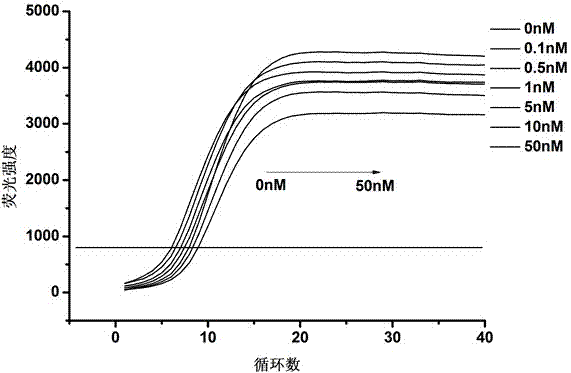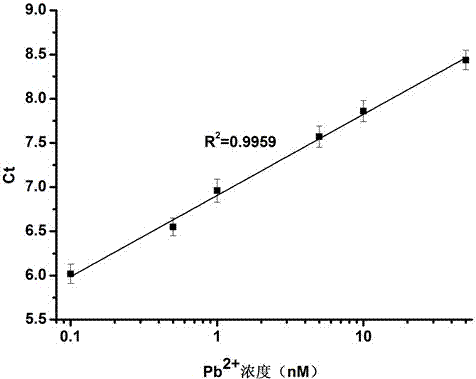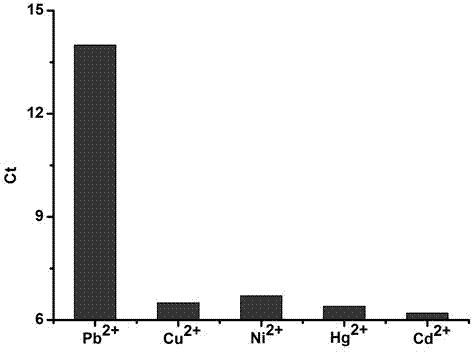Method for detecting lead ions based on combination of fluorescence quantitative PCR (polymerase chain reaction) and nuclease GR-5
A GR-5, fluorescence quantitative technology, applied in the field of chemistry, can solve the problem of the lead ion detection method needs to be improved, and achieve the effect of high selectivity, high sensitivity, and improving the detection limit
- Summary
- Abstract
- Description
- Claims
- Application Information
AI Technical Summary
Problems solved by technology
Method used
Image
Examples
Embodiment 1
[0029] Example 1 Design and synthesis of corresponding oligonucleotide fragments;
[0030] The inventors designed a nuclease GR-5 that is dependent on lead ions, and modified it with biotinylation at its 5' segment. Complementary DNA is designed, and finally upstream and downstream primers for real-time fluorescent quantitative PCR are designed according to the sequence. Sequences were prepared by a DNA synthesizer.
[0031] Nuclease GR-5:
[0032] 5'-biotin-GGCTACGAGGGAAATGCGGTAATCATCTCTGAAGTAGCGCCGCCGTAGTG-3' (SEQ ID NO: 1).
[0033] Complementary DNA:
[0034] 5'-AATCTGGTTTAGCTACGCCTTCCCCGTGGCGATGTTTCTTAGCGCCTTACCACTrAGGAAGAGATGATT-3' (SEQ ID NO: 2)
[0035] Upstream primer: 5'-AATCTGGTTTAGCTACGCCTTC-3' (SEQ ID NO: 3)
[0036] Downstream primer: 5'-GTAAGGCGCTAAGAAACATCG-3' (SEQ ID NO: 4)
Embodiment 2
[0037] The hybridization of embodiment 2 DNA and the immobilization;
[0038]First, add 20 μL of 0.8% glutaraldehyde solution to the PCR tube to treat at 37 °C for 5 h, and then wash it with ultrapure water three times.
[0039] Next, treat again with 20 μL of 0.01 M carbonate buffer dissolved in streptavidin at 12.5 ng / mL for 2 h at 37 °C. Wash with PBST (10mM PBS, pH 7.2, 0.05% Tween-20) immediately after treatment.
[0040] Next, 20 μL of the mixture of nuclease GR-5 and complementary DNA was added to PCR tubes respectively, wherein the concentrations of nuclease GR-5 and complementary DNA were both 100 nM, and reacted at 37° C. for 40 minutes.
[0041] Finally, with sodium citrate buffer (750mM NaCl, 75mM C 6 h 5 Na 3 o 7 ) to wash 3 times. to remove unfixed DNA.
Embodiment 3
[0042] Embodiment 3 establishment of standard curve
[0043] Add 20 μL of lead ions to the PCR tubes obtained in Example 2 in order to make the final concentrations 0.1 nM, 0.5 nM, 1 nM, 5 nM, 10 nM, 50 nM, and react at 37 ° C for 40 minutes, and finally use citric acid Wash 3 times with sodium buffer to remove unreacted DNA. Finally, 10 μL of PCR mixture, 2 μL of upstream and downstream primers, and 6 μL of water were sequentially added to the PCR tube for real-time fluorescent quantitative PCR.
[0044] Establishment of lead ion standard curve: Use real-time fluorescent quantitative PCR instrument to measure the cycle number of the amplification curve under different lead ion concentrations, and draw the standard curve of lead ion concentration according to the measured cycle number of the amplification curve under different lead ion concentrations.
[0045] The inventor found that: the linear equation of the standard curve is y=0.91748x+6.90575, y is the cycle number of th...
PUM
 Login to View More
Login to View More Abstract
Description
Claims
Application Information
 Login to View More
Login to View More - R&D
- Intellectual Property
- Life Sciences
- Materials
- Tech Scout
- Unparalleled Data Quality
- Higher Quality Content
- 60% Fewer Hallucinations
Browse by: Latest US Patents, China's latest patents, Technical Efficacy Thesaurus, Application Domain, Technology Topic, Popular Technical Reports.
© 2025 PatSnap. All rights reserved.Legal|Privacy policy|Modern Slavery Act Transparency Statement|Sitemap|About US| Contact US: help@patsnap.com



